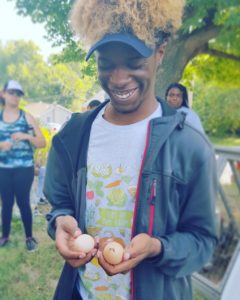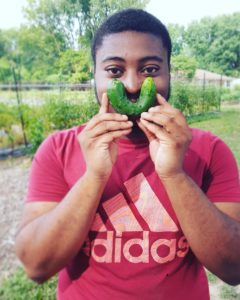When did you start farming?
I’m not actually a farmer per se, but rather a farm educator. I run all of the youth programs at CAASTLC’s Seeds of Hope Farm, with our teen employment program being the bulk of what I do.
What is your background?
I was raised in Southern California and attended college at the University of California Santa Cruz, which is home to many spectacular farms as well as the Center for Agroecology & Sustainable Food Systems. Living and studying among the redwoods at UCSC exposed me to a way of thinking that regarded the natural environment and all its inhabitants as sacred.
Between classes, I would ride my bicycle to the 30-acre campus farm, sit beside my favorite apple tree atop a hill overlooking the ocean, and complete my coursework. These moments of pause shaped my worldview and set me on a path of growing food, cultivating community, and reconnecting young people to the land.
Throughout my time as a student at UCSC, I volunteered at the Santa Cruz Homeless Garden Project – a 3-acre organic farm that provides transitional employment to people who are homeless. This was my first hands-on farm experience and I absolutely loved it! So, about a year after graduation, I traveled to Costa Rica to work on two more farms: Finca Luna Nueva and Rancho Mastatal. These experiences introduced me to biodynamic farming, earthen building, tropical plant medicine and, oh, so much more.
I spent the next couple years of my life traveling, working for Cafe Gratitude (an incredible plant-based restaurant that supports local farmers), and soaking up the Bay Area beauty. I eventually made up my mind to attend graduate school and was lucky enough to earn my MSW right here in Saint Louis. Through a serendipitous encounter with Gabriel Hahn, former farm manager of Seeds of Hope, I landed a graduate school apprenticeship on the farm, which later evolved into a full-time job developing and delivering farm-based youth programs at Seeds of Hope.
How long have you worked on the farm?
I’ve been employed at CAASTLC’s Seeds of Hope Farm for three years. Wow, time flies!
Why is it important for people to know where their food comes from?
Simply put, because knowing how your food was grown and who grew it increases your capacity to practice gratitude for the time, energy, resources and love poured into it.
What has been your greatest struggle as a small farmer in the food industry?
I feel our biggest challenge at Seeds of Hope Farm has been introducing new and lesser-known crops to the residents of Spanish Lake. Certain veggies like heirloom tomatoes and kohlrabi have required a much longer warming-up period than anticipated. We’ve found that much investigation into culturally appropriate foods is necessary to properly tailor our crop to our clientele.
How do you sell your products… do you sell to restaurants, CSA, farmers market or grocery stores? Why did you choose this distribution method?
Seeds of Hope Farm has a unique, two-tiered CSA model. Our CSA members are comprised of both “sponsors” and “subsidized members,” allowing us to offer fresh foods to low-income families at an affordable price. Sponsors pay slightly more than the value of the weekly share to offset the cost of the same box of produce for a subsidized member. We also accept EBT to make our produce even more accessible to families living in low-income households.
On Thursdays from 4-6pm, we also sell our produce at a community farm stand in the Belle-Park Plaza off Bellefontaine Road.
How do you see your role in the community?
Seeing as our farm is situated in a food desert (or food apartheid area), our mission of increasing access to healthy, affordable foods in Spanish Lake is a major priority. However, our work in the community over the past five years has taught us that making fresh fruits and veggies available to those who don’t regularly have access, does not necessarily get at the larger challenge of improving community health. We have therefore broadened our scope and are currently experimenting with ways to shift mindsets around healthy eating. As a suburban farm, we see ourselves as a hub for farm-based education in the community. Through our 6-month teen internship program, farm apprenticeship program and numerous school-based programs, we educate the community about how to grow food as well as where food comes from.
What is your favorite growing season/crop?
My favorite growing season is Fall because the field is bountiful, the air is crisp and, well, because pumpkins are magical.
Check out Seeds of Hope’s Website and Facebook Page!
Join Seeds of Hope’s CSA!



